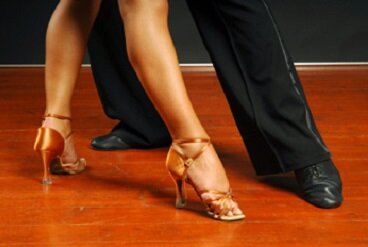Spiral Action Technique 
20 May 2016
The Spiral Action starts showing up in Silver Cha Cha and Rumba, in Gold Paso Doble and Samba, and even in Jive at the Open level. This turn is often daunting when first learnt, but like anything, with a thorough understanding of the technique and studious practice Spiral Actions are possible, and even become easy. This article will discuss exactly what a Spiral Action is, the different types, the technique, and some useful tips and tricks for making Spirals easier for you.
Definition of a Spiral Action
Here's the simple definition: a Spiral Action is whenever a Forward Walk Turning is turned more than 3/8 (if you don't know exactly what a Forward Walk Turning is, check this BGBB article out first). If it is only slightly more than 3/8 turn, it is called a Loose Spiral Action; typically, the Spiral Action turns 7/8; and it is possible to turn 1 7/8 for a Double Spiral or even 2 7/8 for a Triple Spiral.
Let's also be clear about our terminology, here. The Spiral Action (also known as the Curl Action, Spiral Cross, and often just a Spiral) is the technique used to turn. On the other hand, there is a figure in Rumba and Cha Cha called The Spiral, which is essentially an Open Hip Twist with a Spiral Action instead of a Hip Twist Action. To avoid ambiguity, this article is just about the Spiral Action, which is used in various figures throughout Latin.
Technique of a Spiral Action
The technique of a Spiral Action starts with the technique of a Forward Walk Turning, which is described above, but it is taken a little further. Start by dancing the Forward Walk Turning, having made 3/8 turn and ending with slight pressure into the Toe of the front foot. From here, squeeze the ground with your feet, take 95% of your weight onto the standing leg, and rotate both of your feet to the right, so that each foot pivots on the ball. Although the turn is made over the ball of the foot, the heel of the standing leg remains in contact with the floor throughout. In order to achieve the correct crossed position, you must allow the free knee to bend as the leg becomes crossed in front of the standing leg. Your free leg may slide slightly on the ground if your step into the Forward Walk Turning was a large step.
You will end, having turned 7/8, with your free leg crossed in front of your standing leg.
Technique of a High Spiral Action
There is a second type of Spiral Action, called a High Spiral Action or a Toe Spiral Action, which is slightly different from a traditional Low Spiral Action (which is what was just talked about above). There are two main differences between a High Spiral Action and a Low Spiral Action. The first difference is that this type of Spiral Action is done high on the Toe, with the heel well off the ground. The second is that as the turn is commenced, the free leg is brought in to the standing leg so the legs are zipped up to each other, from the tops of the thighs to the ankles, while the free leg is still crossed in front of the standing leg.. It is only possible to have both legs extended while crossed because the High Spiral Action is done so high on the Toe, allowing for vertical room for straightening of the legs.
This type of Spiral is more often used by the Lady than the Man, and while it is more difficult, it allows for a more beautiful leg line and the tightness of the body around the axis of rotation can allow for faster spinning.
The Double Spiral Action
The Spiral Action (high or low) can be overturned in more advanced choreography. Typically, a Double Spiral makes not 7/8 turn, but 1 7/8. When dancing a Double Spiral, the free toe will slide along the floor as additional turn is made over just one foot. This can be extended into a Triple Spiral by making an additional two full turns, and theoretically it can be continued for as long as you can maintain balance and momentum.
Tips and Tricks to Make your Spiral Actions Effortless
Two Feet
Try this exercise. Stand on two feet, then stand on one foot. In which of those two positions do you feel more stable? Obviously, two feet. So then why do so many dancers try to dance the Spiral Action on one foot, where they are least stable? The first 3/8 of this turn is made with strong weight into two feet, and the final 1/2 is made with pressure into the Toe of the free foot. Paying attention to the distribution of your weight will make your Spiral Actions much easier.
End Underturned
As discussed above, the total amount of turn made should be 7/8, and between the end of this turn and the first step of your next forward Walk, you should make an additional 1/8 turn. Always end Spiral Actions underturned by 1/8 to allow for momentum to continue into the next step, and to avoid being in a square position.
The Power Comes from the Legs
The novice will often try to power the turn by throwing his arms and upper body into rotation, but this will cause a loss of balance. Instead, feel that the power comes from squeezing the floor between your feet. If you can maintain a strong squeeze and you initiate the turn, that squeeze will turn into rotational power without causing you to lose balance.
Double Spiral Action
When dancing more turns, you need more of two elements: time, and power. To dance a Double Spiral Action successfully, take an extra half beat for the first full turn, and also put more power into your turn.